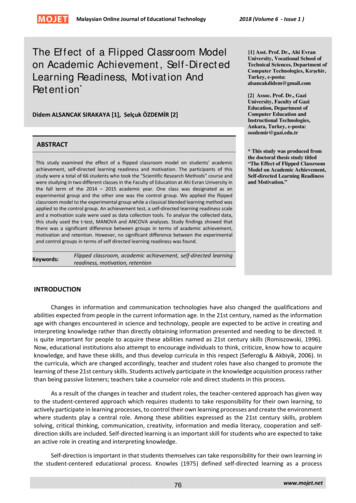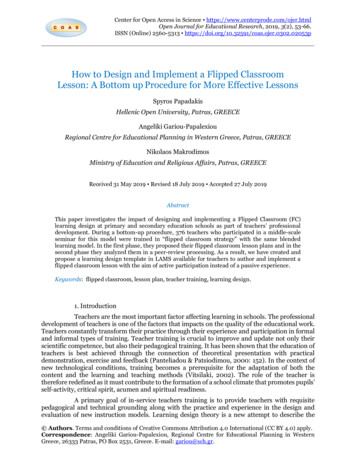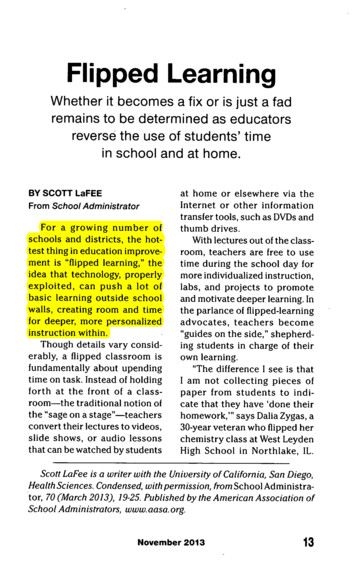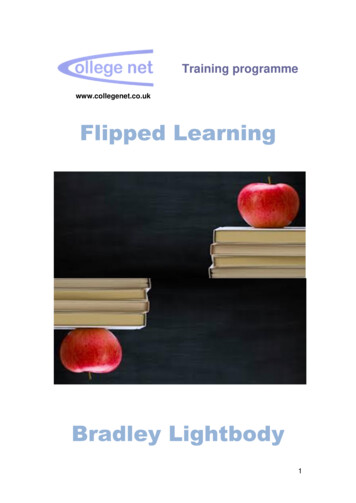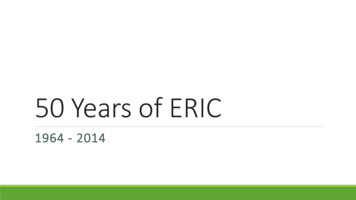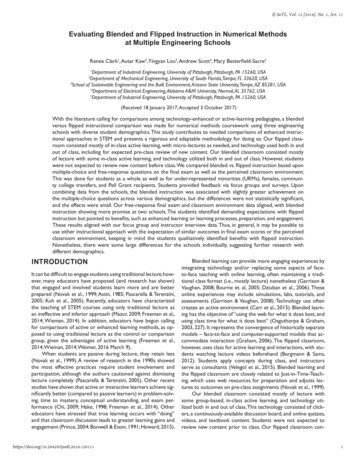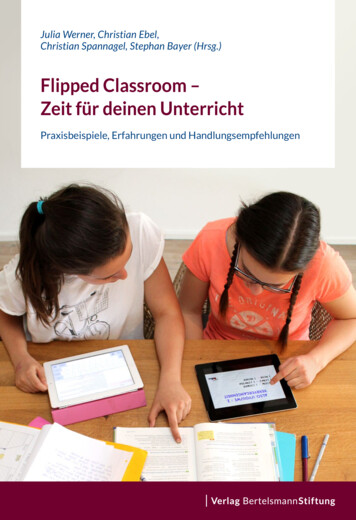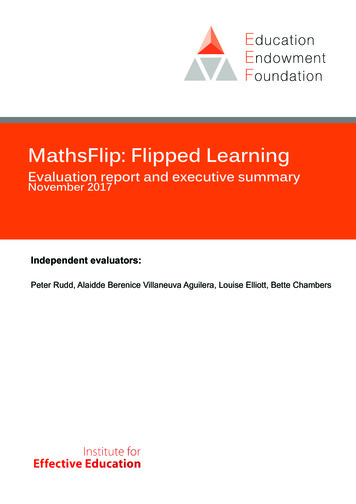
Transcription
MathsFlip: Flipped LearningEvaluation report and executive summaryNovember 2017Independent evaluators:Peter Rudd, Alaidde Berenice Villaneuva Aguilera, Louise Elliott, Bette Chambers
The Education Endowment Foundation (EEF) is an independent grant-making charity dedicated tobreaking the link between family income and educational achievement, ensuring that children from allbackgrounds can fulfil their potential and make the most of their talents.The EEF aims to raise the attainment of children facing disadvantage by: identifying promising educational innovations that address the needs of disadvantaged childrenin primary and secondary schools in England; evaluating these innovations to extend and secure the evidence on what works and can bemade to work at scale; and encouraging schools, government, charities, and others to apply evidence and adoptinnovations found to be effective.The EEF was established in 2011 by the Sutton Trust as lead charity in partnership with Impetus Trust(now part of Impetus - Private Equity Foundation) and received a founding 125m grant from theDepartment for Education.Together, the EEF and Sutton Trust are the government-designated What Works Centre for improvingeducation outcomes for school-aged children.For more information about the EEF or this report please contact:Danielle MasonHead of Research and PublicationsEducation Endowment Foundation9th Floor, Millbank Tower21–24 MillbankSW1P 4QPp: 020 7802 1679e: danielle.mason@eefoundation.org.ukw: www.educationendowmentfoundation.org.uk
Flipped LearningAbout the evaluatorThe project was independently evaluated by a team from the Institute for Effective Education at theUniversity of York.The lead evaluator was Dr Peter Rudd. However, he left the IEE in Spring 2016. Bette Chambers is thecontact person.Contact details:Professor Bette ChambersInstitute for Effective EducationUniversity of YorkHeslingtonYorkYO10 5DDp: 01904 328153e: bette.chambers@york.ac.uk1Education Endowment Foundation
Flipped LearningContentsExecutive summary . 3Introduction. 5Methods . 8Impact evaluation . 14Process evaluation . 21Conclusion . 25References . 27Appendix 1: EEF cost rating . 28Appendix 2: Security classification of trial findings . 29Appendix 3: Interview Schedule for Shireland Collegiate Academy Staff . 30Appendix 4: Online Teacher Survey (pre-intervention) . 31Appendix 5: Online Teacher Survey (Post-intervention). 35Appendix 6: Teacher Telephone Interview Schedule . 44Appendix 7: Lesson Observation Sheet . 45Appendix 8: Schedule for Focus Groups with Teachers . 47Appendix 9: Schedule for Focus Groups with Pupils . 48Appendix 10: Information and consent forms for headteachers and parents . 49Appendix 11: Information sheet/opt-out form for parents . 512Education Endowment Foundation
Flipped LearningExecutive summaryThe projectThe MathsFlip intervention aimed to improve the attainment of pupils in Years 5 and 6. The programme,developed by Shireland Collegiate Academy, used a ‘flipped learning’ approach involving pupils learningcore content online, outside of class time, and then participating in activities in class to reinforce theirlearning. The programme used an online learning environment which provided teachers and pupils withresources for learning mathematics outside the classroom, allowed collaborative communicationbetween colleagues and pupils, and provided information to teachers on pupils’ progress prior toplanning and teaching a lesson. Staff from Shireland trained Year 5 teachers from 12 primary schoolsin the West Midlands over two days and provided some ongoing support.The project was a randomised controlled trial involving 24 schools: 12 schools received the interventionfrom April 2014 until April 2015 using MathsFlip to deliver lessons at the start of a new maths topic forthe cohort of pupils in Year 5; 12 schools acted as control schools delivering maths lessons in the usualway. Impact was measured using pupils’ Key Stage 2 (KS2) maths scores in summer 2015. The processevaluation involved lesson observations and collecting teachers’ and pupils’ perceptions of theprogramme through interviews with staff, focus groups, and online teacher surveys. The project wasfunded as part of the EEF Digital Technology funding round in collaboration with the Nominet Trust.Key conclusions1. Children in MathsFlip schools made the equivalent of one additional months’ progress in maths,on average, compared to children in comparison schools. The three padlock security ratingmeans this result is moderately secure.2. The impact on maths was slightly higher for children eligible for free school meals (‘FSM pupils’)than for all children in the trial. These results are less secure than the overall findings becauseof the smaller number of pupils.3. Children in MathsFlip schools made three additional months’ progress in reading and writing, onaverage, compared to children in the other schools. However, this result should be treated withcaution. First, there is not an obvious route by which this maths intervention could improveliteracy results so much more than maths results. Second, the relatively small number of schoolsinvolved increases the likelihood that we would see a result like this just by chance rather thandue to the intervention itself.4. The majority of teachers in the trial were very positive about the flipped learning approach andthe technical and professional support they received from Shireland staff. The process evaluationsuggests this support was necessary for successful implementation.5. Some teachers experienced technical problems with the online platform; these were generallydealt with quickly by the developers. Some pupils did not have internet access at home: this ledsome schools to set up homework clubs providing online access.EEF security ratingThese findings have moderate security. This trial was an efficacy trial which tested whether theintervention worked under developer-led conditions in a number of schools. The trial was a welldesigned two-armed randomised controlled trial. Relatively few pupils—only 7% of those who startedthe trial—were not included the final analysis. The pupils in MathsFlip schools were similar to those inthe comparison schools in terms of levels of FSM eligibility and prior attainment. However, the trial was3Education Endowment Foundation
Flipped Learningpowered to detect an effect of 0.37, higher than the expected EEF maximum of 0.2. Therefore, twopadlocks were lost, reducing the security of the trial.Additional findingsMathsFlip appeared to have only a small impact on KS2 mathematics achievement at the end of Year6. The impact observed for KS2 reading and writing outcomes was higher, however this result shouldbe treated with caution for two reasons. First, there is not an obvious route by which this mathsintervention could improve literacy results so much more than maths results. Second, the relatively smallnumber of schools involved increases the likelihood that we would see a result like this just by chancerather than due to the intervention itself.Despite some initial start-up problems and challenges with teachers’ lack of familiarity with thetechnology, both teachers and pupils reported very positive perceptions of the intervention. Someteachers did comment that it demanded a high level of independence from pupils and support fromparents to make the approach work. There were issues with accessing the online platform at home forsome pupils. Teachers positively rated the support that they received from the Shireland implementationsupport staff.CostMathsFlip cost about 4,400 per school, or 147 per pupil per year when averaged over three years.Schools also need to meet the cost of staff cover for 3 days of training for each participating teacher.Participating pupils also need access to the internet to complete activities outside of class time, eitherat school or at home.Summary of impact on main outcomesOutcome/GroupKS2 MathsEffect size(95% confidenceinterval)0.09(-0.28 to 0.46)KS2 Maths0.10FSM pupils(-0.21 to 0.40)Estimatedmonths’progressNo. EEF costrating N/A 4Education Endowment Foundation
Flipped LearningIntroductionIntervention‘Flipped learning’ (often referred to as the ‘flipped classroom’ or ‘blended learning’) is an approach inwhich pupils are given assignments to do at home on computers or tablets and teachers collect feedbackprior to the lesson. These may include video lessons made by the teacher or online activities related tothe content. This pre-learning experience enables the teacher to use classroom time for activities suchas co-operative learning, problem-solving, projects, and attending to individual difficulties. Prior to thelesson, pupils access concepts and acquire knowledge at home, thus teachers spend more lesson timeworking on problem-solving and on higher order thinking tasks in class to help develop pupils’ thinking.The intervention was delivered from April 2014 to April 2015 to the treatment group and from April 2015to the control schools (with the new Year 5 pupils). The MathsFlip programme was developed byShireland Collegiate Academy taking as a basis the flipped learning approach that was implemented byShireland teachers.The key element of the MathsFlip programme was the online learning environment, based on theMicrosoft Office 365 platform, which provided teachers and pupils with resources for learningmathematics outside the classroom. The learning platform was developed by Shireland staff andconsists of two main elements: (1) the class site and (2) the learning zone. The class site was apersonalised page for each class. It contained individual areas where teachers could upload resourcesfor colleagues and pupils to access (such as videos, links, and documents) and shared areas thatallowed collaborative communication among the members of the class (for example, announcements,calendar, discussions).The learning zone was a resource bank based on the learning objectives for mathematics according tothe national curriculum. The learning zone allowed teachers to access resources specific to the topicsthey selected. These selected resources were then shared with the pupils through class sites.Resources were organised by topic, Year (that is, level of difficulty), and presentation type (for example,video, Power Point). Resources included maths games and teaching programmes such as Mangahighand MyMaths.The MathsFlip approach depended on the pupils having access to laptop computers (Shirelandssupplied 30 laptops to each school which pupils could take home). In multiple form entry schools, staffhad to manage this process to ensure equality of access for pupils. It also depended on pupils havinginternet access at home to work on learning activities after school. Where this was not the case, schoolsprovided lunchtime, before-school, or after-school sessions during which pupils could complete theseactivities.Year 5 teachers were trained in the use of the MathsFlip platform in two hands-on day-long sessions.This was repeated with Year 6 teachers as pupils progressed to the next academic year. The projectdirectors, project manager, and the e-learning team (members of the Shireland Collegiate Academystaff) delivered the training using the MathsFlip methodology. The aims of the training were to: introduce the flipped learning methodology; explain how MathsFlip could be used to support the delivery of mathematics; and access the MathsFlip online area (the learning zone) and work with the different tools (forexample, to enable the embedding of videos or uploading work).On the first day of the training, teachers were introduced to the flipped learning approach and shownhow this might look in mathematics. They were also shown how to use the MathsFlip resources in theirmathematics teaching. Following an evaluation at the end of the day, the second day focused ontechnical support and how to use the class sites. For the second day, teachers self-selected the right5Education Endowment Foundation
Flipped Learninglevel of training based on their previous knowledge and confidence of flipped learning and their use oftechnology. These initial sessions were followed up by a further session six months later where teachersevaluated the kind of extra support they needed resulting in the creation of a support plan to meet theirindividual needs. As a result, one large school with four Year 5 teachers asked for additional training; inresponse, the project manager attended the school to deliver two more sessions.In addition to the initial training, treatment schools received ongoing support. The project manager maderegular visits to the treatment schools to help them with the planning and delivery of some activities.She visited every school and helped teachers to write an action plan to think about how the programmecould be implemented in their school. She provided feedback on the lessons and coached teachers whoneeded extra support. Furthermore, hands-on workshops were organised in schools to explain theapproach to parents and to show them how to access the resources and how to assist their children inusing the learning materials.Background evidenceThe flipped learning approach has been widely used in the last decade, largely in secondary and highereducation contexts (Bentley, Allan and Belton, 2014; Dunn, 2013; Educause, 2012; Flipped LearningNetwork, 2014; Vincent, 2013). Opinions exist, published mainly in blogs, teachers’ forums, andpractitioner-oriented magazines, suggesting that the approach might work in other settings (Bergmannand Sams, 2012; Fulton, 2012, Moran and Young, 2015). Teachers all around the world are trying theapproach in their classrooms and many report positive perceptions in the Flipped Learning Network(FLN).A recent review suggests rationales for why flipped learning might improve learning, but they do notpresent actual comparisons of flipped learning and traditional teaching (Hamdan et al., 2013). Most ofthe studies are from higher education settings. However, caution should be employed as sometimesstudents can become disengaged with flipped or blended learning programmes, with one studysuggesting that up to 25% of pupils had become disengaged with the approach (Loch and Borland,2014). If students do not complete the prerequisite activities or readings before class they are less likelyto be able to engage with the in-class activity. Although the flipped learning methodology is now usedin the U.K. it has not been assessed rigorously in a U.K. context. Furthermore, there do not seem toexist any rigorous studies with comparison groups at the primary education level. Therefore there areno studies to base effect size estimates on. It is important to conduct a study to determine if there isevidence behind what is becoming a popular approach.Given the popularity of flipped learning and the weakness of the evidence base, the EEF and NominetTrust co-funded a one year randomised controlled trial (RCT) to provide some high quality evidence onthe impact of flipped learning in English schools. This was part of a funding round focused on digitaltechnology.Shireland Collegiate Academy is widely acknowledged as a leading school in its use of technology.Shireland had been using technology and flipped learning in its classrooms for several years andbelieved that it was able to take the model to other schools. As such, it developed the MathsFlip projectto train primary school teachers to implement a flipped learning approach to maths with Year 5 and Year6 pupils.An efficacy trial was conducted to provide evidence of impact using a robust RCT design.Evaluation objectivesThe Institute for Effective Education (IEE) conducted an impact and process evaluation to rigorouslytest the effectiveness of the intervention by means of a randomised controlled trial. This efficacyevaluation was designed to assess whether flipped learning had an impact on pupils’ numeracyattainment and pupils’ performance in mathematics at Key Stage 2. A process evaluation was also6Education Endowment Foundation
Flipped Learningconducted to develop an understanding of the MathsFlip approach and assess teacher and pupilperceptions of it.Ethical reviewThe evaluation team obtained ethical approval from the Department of Education, University of YorkEthical Review Panel on 29 January 2013. Headteachers signed an agreement outlining the maincommitments of the three parties in the study: the school, the project developers, and the evaluators.The evaluation team provided information and opt-out consent forms for parents and guardians.Data management was in accordance with the Data Protection Act (1998). The trial database is securelyheld and maintained on the University of York’s research data protection server, with non-identifiabledata. Confidentiality is maintained and no one outside the trial team has access to the database. Datawas checked for missing information and double entries. All outputs were anonymized so that no schoolsor students can be identified in any report or dissemination of results.Project teamDr Peter Rudd, Principal Investigator (retired January, 2016).Dr Alaidde Berenice Villanueva Aguilera, Research Associate.Ms Louise Elliott, Data Manager.Professor Bette Chambers (took over write-up of final report February, 2016).Trial registrationThis trial was registered at ISRCTN, number 20851469.https://www.isrctn.com/search?q &filters intervention%3AMathsFlip%2CfunderName%3AEducation Endowment Foundation&searchType advanced-search7Education Endowment Foundation
Flipped LearningMethodsTrial designA two-armed randomised controlled efficacy trial was carried out. Randomisation at school level waspreferred over randomisation at class level to avoid ‘contamination’ within schools and increase thepossibilities of collaboration among teachers within each school.Schools participating in the project paid 1,000 each and received training and support for their Year 5teachers from the MathsFlip team from Shireland Collegiate Academy in spring 2014 for the treatmentschools, or after the evaluation was completed for the control schools. These teachers implemented theMathsFlip approach from April 2014 through to April 2015. The developers intended that Year 5 teacherswould follow their pupils into Year 6, however this is not common practice in schools so most pupils inYear 6 had different teachers (who were also trained in MathsFlip). Shireland responded by training theteachers in Year 6 at the end of July and beginning of September. This made the intervention a yearlong treatment spanning two academic years. However, limited engagement from Year 5 teachers whoonly had one term with pupils did delay the embedding of the approach with these pupils.Teachers in the control group delivered ‘business as usual’ maths lessons. Year 5 teachers in controlschools received the training and support from April 2015 and worked with their current Year 5 pupilswho then continued with the approach into Year 6.Participant selectionAll primary schools with high proportions of pupils with FSM eligibility in Birmingham and the BlackCountry area were eligible to express an interest in the project. Schools were invited to participate byShireland Collegiate Academy project staff. Although the schools were geographically close they werenot a network or a fixed group prior to participation in the project.Fifty-two schools expressed an interest in participating in the study; 24 were selected by the IEE,choosing those that had low prior attainment and high levels of socio-economic deprivation (based onthe proportion of pupils receiving free school meals).Prior to randomisation, a launch event took place at the Botanic Gardens in Birmingham. Staff membersfrom all 24 schools selected for the project were invited to meet the project partners (funder, deliverer,and evaluator) and learn about their role in the project. Nearly all the headteachers and Year 5 teachersfrom the 24 schools, along with other interested parties (such as governors) attended this event.Also prior to randomisation in March 2014, headteachers of each school were briefed on the objectivesof the programme. Consent was obtained from each school by means of a letter sent to the headteacherand the potential MathsFlip co-ordinator (the latter identified when the schools volunteered toparticipate). The letter explained the purpose and nature of the evaluation and was signed by theheadteacher at each school once it was chosen to participate.Headteacher consent was obtained before randomisation. In January 2014 a letter was sent, via theschools, to parents and this included an opt-out form if a parent did not wish for their child to take partin the evaluation activities. Parent assemblies were also organized to provide further information on theprogramme and evaluation. (See Appendix 8 for the headteacher consent forms and Appendix 9 for theparent letter and opt-out forms.)Thirty laptops were delivered to each school. If schools were larger that single form entry schools theschool either provided laptops to the children or classes shared the laptops that Shireland gave them.Control schools were loaned laptops, but only after the trial had finished.8Education Endowment Foundation
Flipped LearningOutcome measuresKS1 mathematics assessments were used as the primary baseline measure. However, since KS1 SATsare assessed by the class teachers, an additional test—Progress in Maths (PiM)—was administered toestablish baseline equivalence between treatment and control groups.There was some discussion about whether to use the PiM test (an online test developed by GLAssessment had been administered by teachers in March 2014 prior to randomisation underexamination conditions) or use national Key Stage tests. It was not possible to obtain all the data fromthe pupils who sat the baseline test and so it was collectively decided—between the EEF and IEE—thatthe KS1 results would be the key baseline measure in the final intention-to-treat analysis and the PiMscores would not be used.The KS2 maths score was the primary outcome measure, obtained by the evaluator from the NationalPupil Database. The schools sent the unique pupil numbers (UPNs) of the pupils in the study to theevaluator who requested the matched KS1 and KS2 scores for each pupil. These measures are high incontextual validity as they constitute the main indicators of pupils’ academic performance in England.Pupils in the intervention and control arms of the trial cohorts sat the KS2 tests in May and June 2015.The secondary outcomes were KS2 average point score, and English—defined as reading and writingscores at KS2. Writing and reading outcomes were chosen to examine the potential spill-over effect ofMathsFlip to other subjects. The protocol also states that attendance data and pupil engagement withthe flipped learning virtual learning environment would be collected. Shireland collected this data but itwas not requested by the IEE at the time of analysis therefore it is not possible to include in thisevaluation report.Statistical power was assessed using Optimal Design software. Based on prior experience with similarclustered analyses, assumptions and details were made as follows and included in the protocol: number of schools: 24; students per school per year group: 60; classes per school: 2; pre-post (KS1-KS2) correlation (squared): 0.60; intraclass correlation (KS2): 0.15; criterion for statistical significance: p 0.05; Minimum Detectable Effect Size: in the protocol, 0.20 (calculations made after the study wasfinished suggest that the MDES at the protocol stage should have been 0.33 not 0.20 as statedin the protocol; the number of schools in the trial limits the power to detect an effect size of0.33); and power: 0.80.RandomisationAs described above, the IEE selected 24 schools to participate. The lead evaluator matched schools inpairs based on similarities in prior attainment (percentage of pupils achieving level 4 or above in KS2maths scores in 2013), pupil premium eligibility, and proportion of FSM pupils (EVERFSM). The IEEdata manager, who knew nothing about the specific schools, then assigned one school of each pair tothe treatment group and the other to the control group using a random number generator.9Education Endowment Foundation
Flipped LearningAnalysisThe ITT (intention to treat) analysis of the primary outcome—pupils’ KS2 maths fine grade scores(KS2 KS2MATFG)—used multilevel modelling (MLM), an analysis in which pupils were nested withinschools. Because randomisation was carried out using matched pairs, the pairings were accounted forby including them as an extra level in the analysis. This resulted in a three-level model, with Pupil nestedwithin School nested within Pair as random effects. The MLM analysis used degrees of freedomassociated with the number of schools, not the number of students. Pupils in schools randomly assignedto flipped learning were compared to those in the randomly assigned control group schools, controllingfor their KS1 maths scores (KS1 MATPOINTS).Secondary analyses of pupils’ KS2 fine grade Average Point Score (KS2 KS2APSFG), fine gradereading (KS2 KS2READFG), and fine grade writing (KS2 KS2WRITTAFG) scores were conductedusing the same model controlling for the corresponding subject’s KS1 points scores. The protocol alsostates that data on attendance would be included as a secondary outcome. However, this data was notrequested by the evaluators so this analysis could not be done.Subgroup analyses were conducted for KS2 mathematics outcomes for boys, girls, and pupils eligiblefor FSM, controlling for their KS1 maths points scores. An analysis comparing high, average, and lowachievers was conducted. The pupils were categorised as ‘high’, ‘average’, or ‘low’ achievers based ona division of the KS1 mathematics scores into three levels of similar size.It was also intended that an analysis of pupil engagement with the flipped learning VLE would take placeto analyse if the degree of engagement had an impact on outcomes for those pupils in the treatmentarm. We did not collect this data, therefore this analysis could not be conducted.The effect size was calculated using Hedges’ g. Since this was a cluster randomised trial, there areoptions for the calculation of the effect size (Hedges, 2007). Accordingly, we calculated the effect sizeusing the difference between the arms in the adjusted means (accounting for pairing) divided by theunadjusted total standard deviation in the KS2 outcome.Implementation and process evaluationA process evaluation was conducted to develop an understanding of the context of the MathsFlipapproach, of the day-to-day delivery of the intervention, and the teachers’ and pupils’ perceptions. Fiveresearch instruments were developed to provide a detailed picture of implementation of the programmeand of perceptions of it. It also helped to inform and explain the impact evaluation findings. The fiveelements were: interviews with implementation staff (see Appendix 1); online teacher surveys (see Appendices 2 and 3); telephone interviews with teachers (see Appendix 4); school visits that included class observation (see Appendix 5); and focus groups with teachers and pupils (see Appendices 6 and 7 respectively).Interviews with implementation staffIn order to obtain a full understanding of the context and the rationale for MathsFlip, five in-depth faceto-face interviews were conducted with implementation staff from Shireland Collegiate Academyincluding the Headteacher, the Project Director, the Project Manager, the Director of Learning and theIT technicians who supported the project (see Appendix 1).The interviews were conducted to gain an in-depth understanding of the nature of the programmeincluding its origins and development as well as the process for training and implementation. Theinterviews were conducted by two members of the evaluation team and were fully transcribed. The10Education Endowment Foundation
Flipped Learningtranscripts were analysed via qualitative content analysis (Schreier, 2014). A coding frame wasdeveloped and the transcripts were analysed in a systematic way to develop a detailed understandingof: the design and development process; the aims and intended outcomes of MathsFlip; the core and flexible components of the model; how the approach can be differentiated from standard classroom practice; training and implementation support offered to schools; and barriers and potential challenges for implementation and delivery.Online staff surveysTwo online surveys were administered to all Year 5 and Year 6 teachers in both treatment and controlgroups (those teachers who were imp
Bette Chambers is the contact person. Contact details: Professor Bette Chambers Institute for Effective Education University of York Heslington York YO10 5DD p: 01904 328153 e: bette.chambers@york.ac.uk . Flipped Learning . The learning zone was a resource bank based on the learning objectives for mathematics according to the national .


